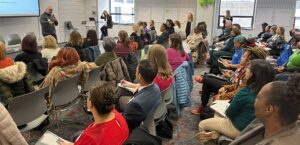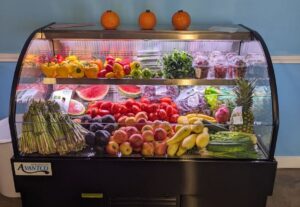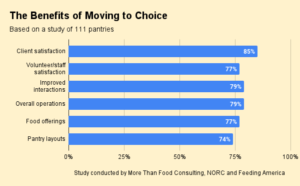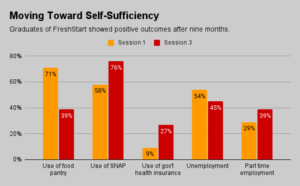The results of a three-year study published this spring in the Journal of Hunger and Environmental Nutrition are a reminder that even as pantries focus on distributing emergency food during the pandemic, there is value in connecting clients to social services that go beyond food.
The study of 484 people found that food pantries that work to address the root causes of hunger can positively impact their clients’ lives. Over the course of the study, the level of food insecurity among participants decreased from 70% of households to 25%, while scores related to self-sufficiency, diet quality and social support all increased.
The study took place at seven food pantries around the country that utilize the More Than Food framework, an initiative housed at the Institute for Hunger Research & Solutions at Foodshare, a Conn.-based regional food bank. More Than Food seeks to address the acute need for food, as well as provide additional services and support aimed at improving clients’ lives. Given the results of the study, the framework is poised to be applied more widely.
“This evidence shows that the framework can be scaled more broadly within the charitable food network, and can be successfully incorporated into very diverse food pantry settings,” wrote the authors of the study.

More Than Food includes three components described as the “three Cs” by Katie Martin, PhD, Executive Director of the Foodshare Institute for Hunger Research & Solutions. The three Cs — choice, connection and culture — are built on values that include emphasizing a person’s potential (not deficits) and recognizing that clients may have faced trauma and social injustices in their lives.
Choice allows for clients to choose their own food, picking the items they prefer in a space with a variety of healthy options. Choice of food creates dignity by empowering clients. Instead of handouts, people get the food they want and need. Another benefit of choice is a decrease in food waste.
“It’s a real paradigm shift within charitable-food work,” Dr. Martin said. “It’s the difference between food volunteers and staff putting food in identical bags, to ways you could set up the food pantry to look more like a market.”
She added, “If you create a food pantry that allows choice, we know that goes a long way in the rest of their lives.”
Connection ties clients to community resources. Through training with the More Than Food program, coaches conduct motivational interviews that facilitate change in a person’s life and help them accomplish their goals.
Culture welcomes people with dignity, which empowers behavioral change. “It breaks down the barrier between ‘us and them,’” Dr. Martin said. “Volunteers are spending more time making a connection and having a conversation.”
Through surveys at the onset of the program, four months into it, and then at the end of nine months, the results of the study showed a decrease in the odds of being food insecure of 82%. People also had more access to fruits, vegetables, and fiber sources.
The results translated beyond food. Social support increased by more than 30%. Significant improvements in self-sufficiency, which includes employment, mental and physical health, transportation, child care, and education, were also evident at four months and again at nine months.
Dr. Martin doesn’t think the More Than Food framework is just for one type of food pantry. In fact, the study included pantries in a predominantly Hispanic community in El Paso, Texas, in African-American and Hispanic neighborhoods in Hartford, Conn. and in mostly white neighborhoods in suburban Rhode Island.
“I like the saying ‘When you’ve seen one food pantry, you’ve seen one food pantry.” While the setup may be slightly different place to place, she thinks any food organization could benefit from the More Than Food program.
In addition, Covid-19 has created new opportunities for applying the framework. The pandemic shows more ways that the More Than Food program is needed, specifically with helping people juggle bills, access SNAP benefits, as well as apply to jobs and unemployment benefits.
“It’s a great opportunity to see how food banks can change,” Dr. Martin said. “If they hadn’t been doing it before, we can serve as a resource now.”
In other research, the Institute found that many households are seeking charitable food for the first time because of the pandemic. The Institute conducted surveys with over 500 people coming to a new Foodshare drive-through distribution program to ask about their food needs. Over 70% of respondents had never received free groceries prior to Covid-19.
In the interest of meeting the unprecedented need, some of the principles related to More Than Food have been set aside in recent months. “Client choice really took a back seat because of health concerns in the pandemic. Coaching took a back seat,” Dr. Martin said. “It became an ‘all hands on deck’ mindset.”
However, the majority of respondents also said they would benefit from talking with a coach to work on goals of budgeting money and other support items. Due to economic challenges during the coronavirus pandemic, almost 70% of households said they had to choose between paying for food and paying bills.
Dr. Martin sees an occasion for food banks to take advantage of the More Than Food program.
“Many of us are settling into our new normal, so hopefully we can be thoughtful about what comes next,” Dr. Martin said. “How can we be better than before?” — Monica Sager
Monica Sager is a freelance writer from Clark University, studying psychology and journalism. Monica has previously been published in The Pottstown Mercury, The Week UK, and Worcester Telegram and Gazette. Read more of her previous work on her Twitter @MonicaSager3.
Connect with Us:















